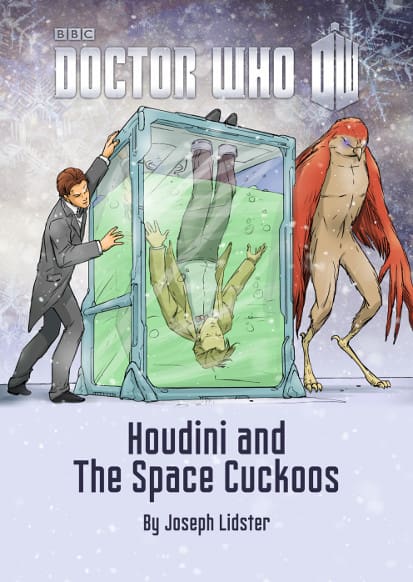
Adventure Calendar
Houdini and The Space Cuckoos
Sets:
Adventure Calendar
Reviews and links from the Community
This review contains spoilers
Review of Houdini and The Space Cuckoos by deltaandthebannermen
Houdini and the Space Cuckoos was a four part short story published on the BBC website around Christmas 2012.
Harry Houdini is a person the Doctor has long claimed to have a history with. As far back as Planet of the Spiders, the Doctor has boasted of his friendship with Houdini but it has taken until the expanded universe of the new series before we have actually been party to any of the Doctor’s meetings with the famed escapologist.
The first of these, chronologically, features the 11th Doctor and is set in New York City, 1920. During one of his acts, involving escaping from a safe, Harry finds a doorway to the TARDIS at the back of it. Enlisting Harry’s help, the Doctor reveals that aliens called Cuculus are possessing humans in an attempt to spread a virus and kill everyone.
Being a short story, the plot is fast-paced and to the point. Pretty soon after meeting the Doctor, Harry is being whisked away to the alien’s spaceship and using his escapology skills to escape his cell and rescue the Doctor from a glass box filled with liquid. Soon after this, the Doctor discovers the deadly virus and the means to stop it, provided in part by Harry.
The Cuculus are the eponymous ‘Space Cuckoos’ and, based on the illustrations, continue the new series penchant for ‘aliens-that-look-like-animals’ by looking like huge, eight-foot birds. Continuing the ‘cuckoo’ motif, they are planting their minds in humans in much the way that cuckoos put their eggs in other birds’ nests.
Historically, the cover illustration accompanying the story shows the Doctor in a version of Houdini’s ‘Chinese water torture cell’ set-up which he introduced to his act around 1912. Apart from this detail, the Houdini of this story is a simplistic ‘he can escape and the Doctor knows him quite well’. There is little depth to his character and he adapts to the bizarre situation as quickly as the brevity of the story requires. More is brought to the character of Houdini in the other stories coming in the marathon, particularly Smoke and Mirrors, but for now we have the Houdini as might be imagined from the Doctor’s anecdotes of knowing him and being taught his skills. Houdini, here, acts much like Lady Christina or Kazran Sardick – the one story companion – adventurous, adaptable and appealing.
As a whole, the story is written in a quite simplistic way which betrays its roots as a tale published as part of the BBC website’s Christmas Advent calendar – it’s a bit of fun and, dare I say it, written with a younger age group in mind (which isn’t usually a trap Doctor Who writers fall into but seems to be the vibe Joe Lidster is going for with this).
The 11th Doctor too is simplified – he’s the mad man in the box and rushes from predicament to predicament with the enthusiasm of Matt Smith’s most energetic performances.
I’ve meant to read this for ages and am glad I slipped it into my marathon, particularly because of Houdini’s inclusion but, overall, it’s not the sort of Doctor Who story I’ll ever be in a hurry to revisit.
Community Ratings
(Updates coming soon:)
Add the last X members who rated it here
Add number of Favs, and who they are, here


